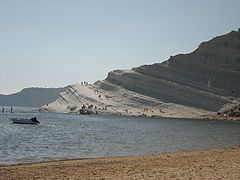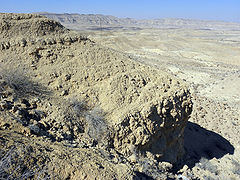- Marl
-
For other uses see Marl (disambiguation).For the red algal growth form, see Maerl.
 Scala dei Turchi coastal marl formation, southern Sicily.
Scala dei Turchi coastal marl formation, southern Sicily.
Marl or marlstone is a calcium carbonate or lime-rich mud or mudstone which contains variable amounts of clays and aragonite. Marl was originally an old term loosely applied to a variety of materials, most of which occur as loose, earthy deposits consisting chiefly of an intimate mixture of clay and calcium carbonate, formed under freshwater conditions; specifically an earthy substance containing 35-65% clay and 65-35% carbonate.[1] It also describes a habit of coralline red alga.[2] The term is today often used to describe indurated marine deposits and lacustrine (lake) sediments which more accurately should be named marlstone. Marlstone is an indurated rock of about the same composition as marl, more correctly called an earthy or impure argillaceous limestone. It has a blocky subconchoidal fracture, and is less fissile than shale. The term marl is widely used in English-language geology, while the terms Mergel and Seekreide (German for "lake chalk") are used in European references.
The lower stratigraphic units of the chalk cliffs of Dover consist of a sequence of glauconitic marls followed by rhythmically-banded limestone and marl layers. Upper Cretaceous cyclic sequences in Germany and marl–opal-rich Tortonian-Messinian strata in the Sorbas basin related to multiple sea drawdown have been correlated with Milankovitch orbital forcing.[3]
Marl as lacustrine sediment is common in post-glacial lake bed sediments, often found underlying peat bogs. It has been utilized as a soil conditioner and acid soil neutralizing agent.
See also
- Agricultural lime
- Keuper marl
- Loam - which is sand and clay rather than lime and clay.
References
- ^ Sedimentary Rocks. Pettijohn, F. J., Harper& Brothers New York 1957, p. 410
- ^ Steneck, R. S. (1986). "The Ecology of Coralline Algal Crusts: Convergent Patterns and Adaptative Strategies". Annual Review of Ecology and Systematics 17: 273–303. doi:10.1146/annurev.es.17.110186.001421. JSTOR 2096997.
- ^ Krijgsman, W (2001). "Astrochronology for the Messinian Sorbas basin (SE Spain) and orbital (precessional) forcing for evaporite cyclicity". Sedimentary Geology 140: 43. Bibcode 2001SedG..140...43K. doi:10.1016/S0037-0738(00)00171-8.
- Schurrenberger, D., Russell, J. and Kerry Kelts. 2003. Classification of lacustrine sediments based on sedimentary components. Journal of Paleolimnology 29: 141-154.
- Chalk of Kent by C. S. Harris Accessed 11/06/2005
- Geochemistry and time-series analyses of orbitally forced Upper Cretaceous marl–limestone rhythmites, abstract Accessed 11/06/2005
- Palaeoenvironmental Interpretation of the Early Postglacial Sedimentary Record of a Marl Lake Accessed 11/06/2005

This article related to petrology is a stub. You can help Wikipedia by expanding it.


